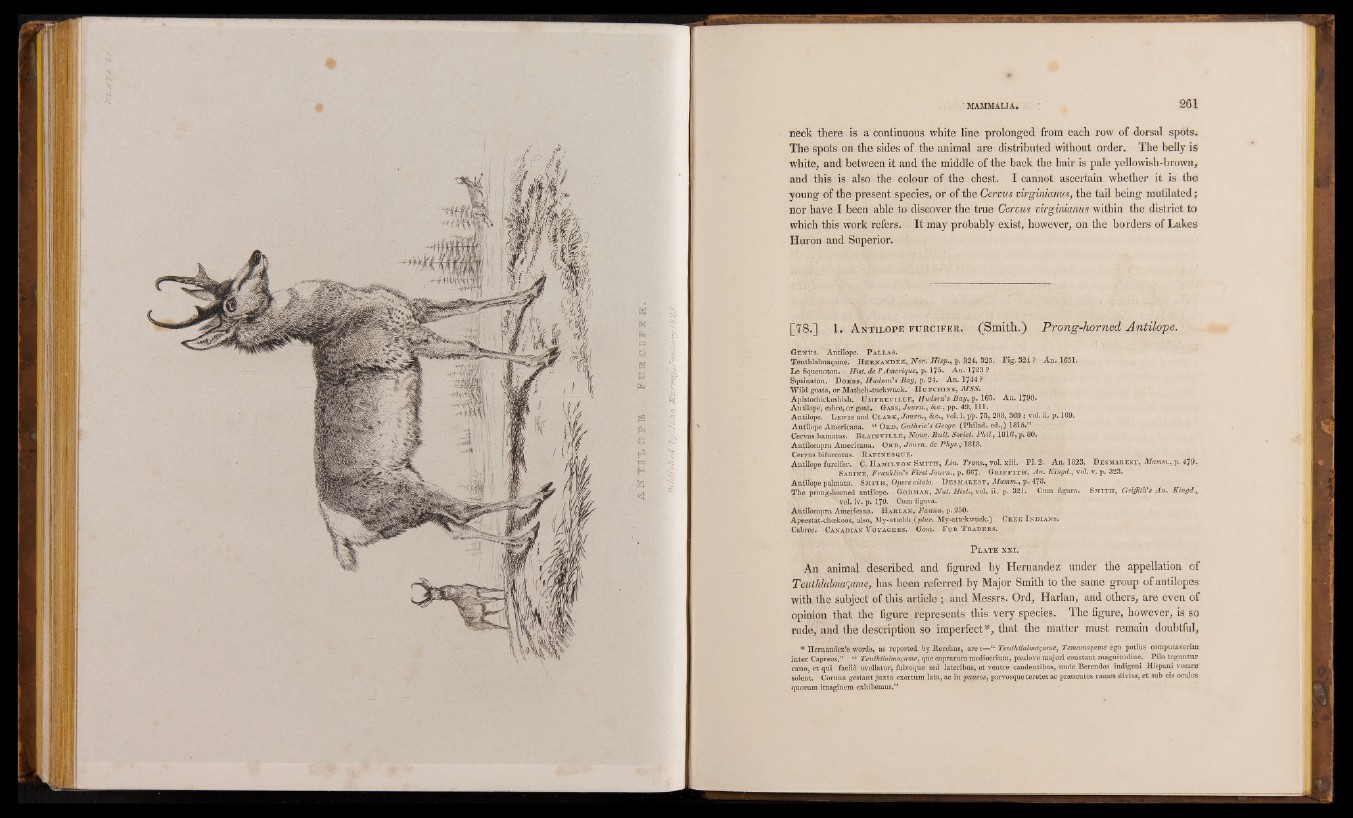
F k t b Murray, // :'’J?f
neck there is a continuous white line prolonged from each row of dorsal spots.
The spots on the sides of the animal are distributed without order. The belly is
white, and between it and the middle of the back the hair is pale yellowish-brown,
and this is also the colour of the chest. I cannot ascertain whether it is the
young of the present species; or of the Germs virginianus, the tail being mutilated;
nor have I been able to discover the true Cervus virginianus within the district to
which this work refers. It may probably exist, however, on the borders of Lakes
Huron and Superior.
[78.] 1. Antilope furcifer. (Smith.) Prong-horned Antilope.
Genus. A n tilo p e '. Pallas.
T e u th la lm a ç am e . Hernandez, N ov. Hisp., p. 3 2 4 , 3 2 5 . F ig . 3 2 4 ? A n . .1651.
L e S q u e n o to n . Hist, de F Amérique, p . 1 7 5 . A n . 1723 ?
S q u in a to n . D o b b s , Hudson’s Bay, p . 2 4 . A n . 1744 ?
Wild g o a ts , o r M a th e h - tu c kw u c k . ' Hutchins, MSS.
A p isto c h ic k o sh ish . U m f r e v i l l e , Hudson’s Bay, p . 1 65. A n . 1730.
A n tilo p e , c a b re , o r g o a t. Gass, Joum., &c., p p . 4 9 , 111.
Antilope. L ew is and Clark, Joum., &c., vol. i. pp. 75, 208,369 ; vol. ii. p. 169.
A n tilo p e A m e r ic a n a . “ O r d , Guthrie's Geogr. (P h ila d . e d .,) 1 8 1 5 .”
C e rv u s h am a tu s . Blainville, N ouv. Bull. Societ. Phil., 1 8 1 6 , p . 80.
A n tilo c a p r a A m e r ic a n a . Ord, Journ, de Phys., 1818.
C e rv u s b ifu rc a tu s . R a f t n e s q u e .
A n tilo p e fu r c if e r . C . Hamilton Smith, Lin. Trans., v o l. x iii. P I. 2 . A n . 1823. Desmarest, Mamm., p . 4 7 9 .
Sabine, Franklin’s First Joum., p . 66 7 . Griffith, A » . Kingd., v o l. v . p . 3 23.
A n tilo p e p a lm a ta . Smith, Opere citato. Desmarest, Mamm., p . 478.
T h e p ro n g -h o rn e d a n tilo p e . G o d m a n , Nat. Hist., v o l. ii. p . 3 2 1 . C um fig u ra . S m i t h , Griffith’s An. Kingd.,
vo l. iv . p . 170. C um fig u ra .
A n tilo c a p r a A m e ric a n a . Harlan, Fauna, p. 250.
À p e e sta t-c hoe k o o s, also , My -a tte h k _ (plur. M y - a tte kw u c k .) Cree Indians.
C a b re ë . Canadian Voyagers. G o a t. Fur Traders.
P l a t e x x i .
An animal described and figured by Hernandez under the appellation of
Teuthlalmaqame, has been referred by Major Smith to the same group of antilopes
with the subject of this article ; .and Messrs. Ord, Harlan, and others, are even of
opinion that the figure represents this very species. The figure, however, is so
rude, and the description so imperfect*, that the matter must remain doubtful,
* H e rn a n d e z ’s w o rd s, a s r e p o r te d b y R e c c h u s , a r e :— “ Teuthtlalmaçame, Temamaçame eg o p o tiu s c om p u ta v e rim
i n t e r C ap reo s.” “ Teuthtlalmaçame, q u e c a p r a rum m e d io c rium , p au lo v e m a jo r i c o n s ta n t m a g n itu d in e . P ilo t e g u n tu r
c a n o , e t q u i fa c ile a v e lla tu r , fu lv o q u e sed la te r ib u s , e t v e n t r e c a n d e n tib u s , u n d e B e re n d o s in d ig e n i H is p a n i v o c a re
Solent. C o rn u a g e s ta n t j u x t a e x o r tum la ta , a c in paucos, p a rv o sq u e te r e te s a c p ræ a c u to s ram o s d iv isa , e t su b e is o c u lo s
q u o rum im a g in em e x h ib em u s.”